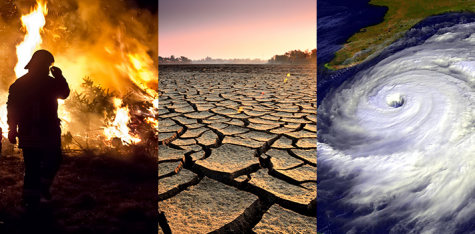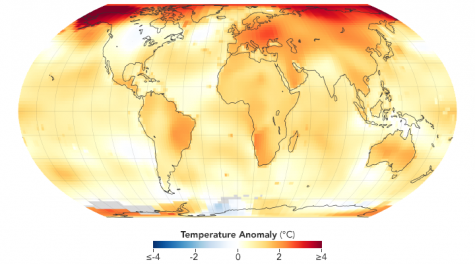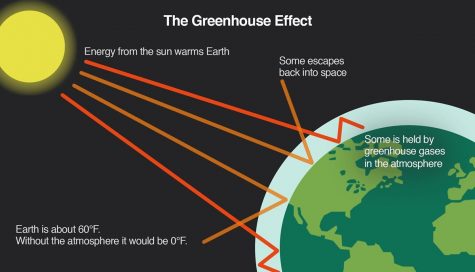Will Heat Be The End Of Humanity?
Recent effects of climate change are moving at a faster rate to bring humanity to a downfall by 2050. But what is being done to slow this down and save the world?
With global climate change on the rise, scientists have high confidence that global temperatures will only continue to increase for decades to come, largely due to greenhouse gases produced by human activities. Current day glaciers have shrunk, ice on rivers and lakes is breaking up earlier, plant and animal ranges have shifted and trees are flowering sooner.
According to NASA, Virtual Signs of the Planet, human activities on earth are changing the natural greenhouse resulting in the burning of fossil fuels like coal and oil has increased the concentration of atmospheric carbon dioxide (CO2) in the last century . This happens because the coal or oil burning process combines carbon with oxygen in the air to make CO2. To a lesser extent, the clearing of land for agriculture, industry, and other human activities has increased concentrations of greenhouse gases.
Climate change is affecting the American people in so many ways. Impacts related to climate change are evident across regions and in many sectors important to society, such as human health, agriculture and food security, water supply, transportation, energy, ecosystems, and others. These impacts are expected to become increasingly disruptive throughout this century and beyond.
Climate change also affects human health and wellbeing through more extreme weather events and wildfires, decreased air quality, and diseases transmitted by insects, food, and water. Climate disruptions to agriculture have been increasing and are projected to become more severe over this century, something that could potentially diminish the security of America’s food supply. According to US EPA climate change can disrupt food availability, reduce access to food, and affect food quality. For example, we are most likely to see an increases in temperatures, changes in precipitation patterns, changes in extreme weather events, and reductions in water availability may all result in reduced agricultural productivity.Surface and groundwater supplies in some regions are already stressed, and water quality is diminishing in many areas, partly due to increasing sediment and contaminant concentrations after heavy downpours.

The National Centers For Environmental Information states, “Winter temperatures were above average across much of the West, Northern Tier, Northeast, and parts of the Southeast. Maine ranked third warmest, and California ranked 12th warmest for the three-month period from December 1 to February 28.” This left below-average temperatures present across parts of the Midwest, like the lower Mississippi Valley, and the southern Plains.
According to independent analyses by NASA and the National Oceanic and Atmospheric Administration (NOAA), Earth’s average global surface temperature in 2019 was the second warmest since modern record-keeping began in 1880. Globally, 2019 temperatures were second only to those in 2016 and continued the planet’s long-term warming trend. The past five years have been the warmest of the past 140 years.
In 2019, global temperatures were 0.98 degrees Celsius (1.8 degrees Fahrenheit) warmer than the 1951 to 1980 mean, according to scientists at NASA’s Goddard Institute for Space Studies. “The decade that just ended is clearly the warmest decade on record,” said GISS director Gavin Schmidt. “Every decade since the 1960s clearly has been warmer than the one before.”

“Climate change is real due to the overwhelming consensus of the scientific community and evidence to support it,” said Sandra Mikesell, a science teacher. Mrs. Mikesell is well rounded on the knowledge of climate change which is the cause of greenhouse gasses, which allow the longer wavelengths of infrared energy to be absorbed, alerting Earth’s climate systems.
“Both positive and negative, which have slowed the rate of temperature change we experience by storing carbon from human emission” Mikesell stated.
Alongside Mrs. Mikesell as an assistant teacher Isabelle Schneyer. Ms. Schneyer explains how the effects of climate change has not only affected America as a whole but also Colorado individuals.
“More intense wildfire seasons caused by prolonged drought, less snowpack volume each year, and record daily high temperatures.” Schneyer stated while explaining the effects we’ve seen just this year in Colorado. Not only in Colorado but along with coastlines as we are seeing more intense hurricanes, too. “With recent hurricanes on coastlines, scientists are even considering adding a category 6 hurricane because the last several have all been category 5,” explained Schneyer.
With both Mikesell and Schneyer working side by side in the Eaglecrest community, both still don’t meet eye to eye on certain things about climate change.
“I hope it is not too late to prevent climate change. I believe that we all need to take immediate and drastic action. I think it is important to commit to making climate conscious decisions.” Mikesell stated. Schneyer had a different perspective, however.
“If we make changes now, we likely won’t see significant differences until a few hundred years have passed,” Schneyer stated. “None of us will be around then, and I think that is the barrier for people to make changes. People don’t want to change their ways now when they won’t ever see the impacts.”
Greenhouse gasses have been seen to be the underlying affect of climate change but is essential for life on Earth, acting as a protective heat blanket. Schneyer explains how these greenhouse gasses naturally occurring, but are also emitted by automobiles, agriculture, and industries which are currently increasing the levels of carbon dioxide, nitrous oxide, and CFCs above what is normal, resulting in climate change. While Mikesell explained the other types of greenhouse gasses and long term impacts for places all over the world.
“Other greenhouse gases are methane, and gases used in air conditioning and refrigerants like hydrofluorocarbons. Greenhouse gases have different global warming potentials, due to the length of time they remain in the atmosphere.” Mikesell explained. With the world heating up drastically, when Earth experiences a 4-degree change, we will have major economic and societal ramifications. Sea level rise will displace large portions of the population, and there could be political conflict over changes in water resources.

It is highly encouraged that younger generations, especially Gen Z –highschool students and young adults– educate themselves on the dangers and effects of climate change as they will be the face of America in a couple years. Being well educated on this topic could potentially spark movements of activism for more of the American population to take this issue more seriously. While the outcomes may not affect us, they can potentially save humanity itself. To get involved, high school students can track their school’s climate impact. Use Portfolio Manager to compare the energy use of your school with other schools nationwide, and earn the ENERGY STAR for your school if it qualifies as a top performer.
The least efficient schools use three times more energy than the best energy performers. By partnering with the highly successful ENERGY STAR for K-12 School Districts and using Portfolio Manager to track and rate the energy performance of school buildings, school districts can serve as environmental leaders in their community, become energy-efficient, reduce greenhouse gas emissions, and save money.
School administrators can also work to reduce their school’s greenhouse gas emissions by developing an inventory EXIT . College & University Green Power Challenge.
Recycling in schools of things like classroom paper, newspapers, beverage containers, electronic equipment, and batteries can make a huge difference. United States Environmental Protection Agency states, “Reducing, reusing, and recycling at school and in the classroom helps conserve energy and reduces pollution and greenhouse gases from resource extraction, manufacturing, and disposal.”
While our understanding of how climate change affects on extreme weather is still developing, evidence suggests that extreme weather may be affected even more than anticipated. Extreme weather is on the rise, and the indications are that it will continue to increase, in both predictable and unpredictable ways.

Described as passionate and independent, editor Rhyan Herrera has been in Nest Network for three years. After this year, she plans on going to a college...





